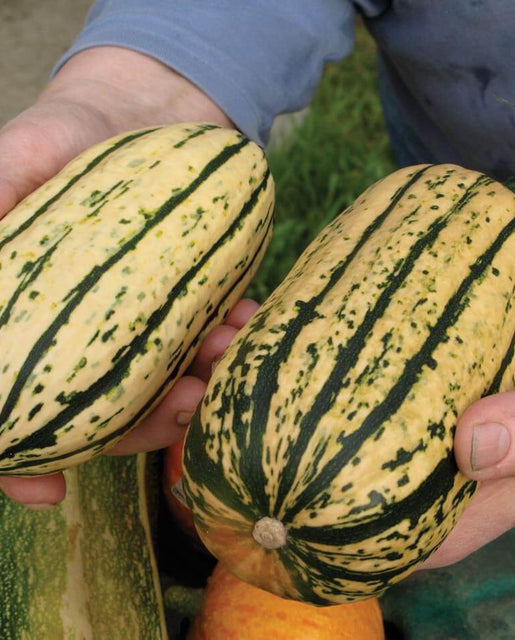For Product Registration and general enquires please contact us

Bush Delicata
$4.99 – $439.99
This variety bears up to eight fruits on each plant! Space them closer together for a higher yield. Bush Delicata squash seeds were a 2002 All America Selections Winner with better resistance to powdery mildew than other delicata types.
West Coast Seeds ships anywhere in North America. However, we are not able to ship garlic, potatoes, asparagus crowns, bulbs, onion sets, Mason bee cocoons, or nematodes outside of Canada. We regret, we cannot accept returns or damages for orders outside of Canada. The minimum shipping charge to the US is $9.99.
Description
More details about Bush Delicata
C. pepo. The same shape, colour, and sweet taste as the well-loved regular Delicata (SQ737), but on much tidier plants. This variety bears up to eight fruits on each plant! Space them closer together for a higher yield. Bush Delicata squash seeds were a 2002 All America Selections Winner with better resistance to powdery mildew than other delicata types. As on any squash, poor pollination sometimes causes plants to abort their fruits. This is when the fruits turn black from the blossom end. To prevent this, be sure to plant pollinator attracting flowers around your squash beds. For this compact bush type, a border of Alyssum will draw in pollinators of all kinds and ensure good fruit set all season long. Matures in 100 days. (Open-pollinated seeds)-
- Up to 8 fruits on each plant
- 2002 AAS-Winner
- Space closer for higher yields
- Open-pollinated seeds
- Matures in 100 days
All About Bush Delicata
How to Grow Delicata Squash

Step 1: Timing
Direct sow or transplant in late spring once the soil is warm. For transplants, start seeds indoors during the first two weeks of May. Optimal soil temperature: 25-35°C (77-95°F). Seeds should germinate in 7-14 days.
Step 2: Starting
Sow seeds 2cm (1″) deep. Sow 3 seeds in each spot where you want a plant to grow, and thin to the strongest plant. Space summer squash 45-60cm (18-24″) apart in rows 90-120cm (36-48″) apart. Give winter squash and pumpkins even more room with a minimum of 90-120cm (36-48″) apart in rows 120-180cm (48-72″) apart.
Step 3: Growing
Ideal pH: 6.0-6.8. These big plants need lots of food. Use 1 cup of complete organic fertilizer worked into the soil beneath each plant. All squash grow male flowers first, at later female flowers. The female flowers have tiny fruits at the base of their petals and require pollination by bees mostly. Incomplete pollination often happens at the beginning of the season, and results in misshapen fruits that are withered at the blossom end. Just discard these damaged fruits before they begin to rot. Encourage bees to visit the garden by growing Phacelia, sunflowers, or buckwheat for improved pollination.
Step 4: Germination
In optimal conditions at least 80% of seeds will germinate. Usual seed life: 2 years. Per 100′ row: 180 seeds, per acre: 15M seeds.
Step 5: Harvest
Summer Squash: Pick when small, if fruit gets big the plant stops producing. Check the plants regularly. Winter Squash: Fruit is ripe if your thumbnail doesn’t mark the skin and the stem is dry and brown. Cut the stem about 4cm (2″) from the fruit. Squash survive a light frost, but store better if harvested before frost. Storage: Field-cure for 10 days in the sun, or cure indoors in a warm room for 4 or 5 days. To prevent mould sponge the skins with a solution of 10 parts water to 1 part chlorine bleach. Store at 10-15ºC (50-60ºF) with low humidity with good air circulation. Try on a shelf in the garage.
Tips!
Disease & Pests: Bacterial wilt (Erwinia tracheiphila) – Remove an destroy infested plants. If striped or spotted cucumber beetles appear, control as early as possible. Powdery mildew – avoid wetting foliage if possible. Water early in the day so that above ground parts of the plants dry as quickly as possible. Avoid crowding plants and eliminate weeds around plants and garden area to improve air circulation. Viral disease – remove and destroy entire infested plant along with immediately surrounding soil and soil clinging to roots. Companion Planting: Companions: corn, lettuce, melons, peas, and radish. Avoid planting squash near Brassicas or potatoes. Borage is said to improve the growth and flavour of squash. Marigolds and nasturtium repel numerous squash pest insects.Additional information
| Matures | in 100 days |
|---|---|
| Season | Warm season |
| Exposure | Full-sun |
| Quantity | 2g, 5g, 25g, 100g, 500g |
You must be logged in to post a review.









Reviews
There are no reviews yet.